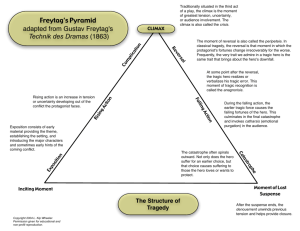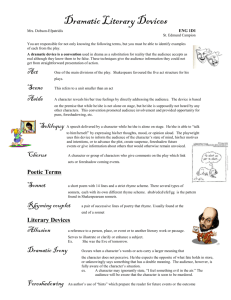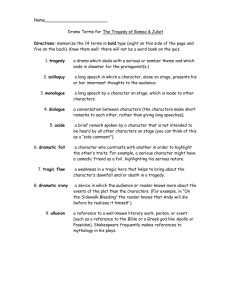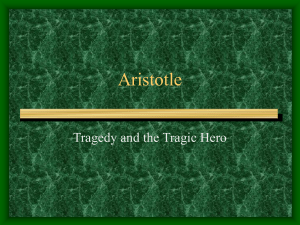Tragedy and the Tragic Hero
advertisement
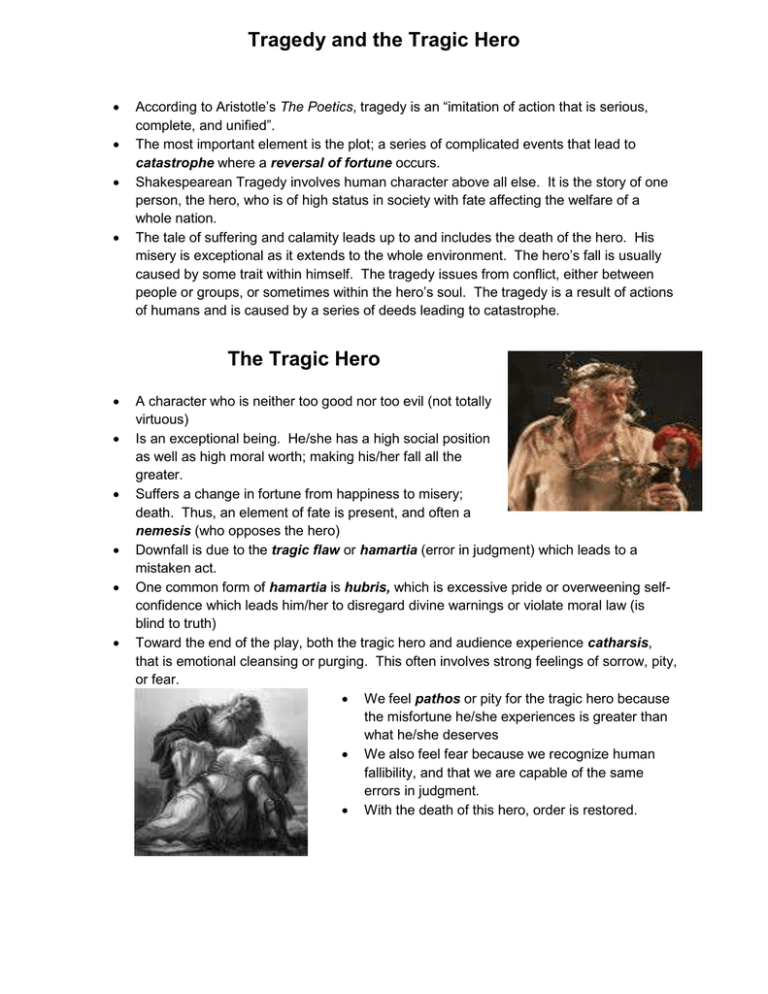
Tragedy and the Tragic Hero According to Aristotle’s The Poetics, tragedy is an “imitation of action that is serious, complete, and unified”. The most important element is the plot; a series of complicated events that lead to catastrophe where a reversal of fortune occurs. Shakespearean Tragedy involves human character above all else. It is the story of one person, the hero, who is of high status in society with fate affecting the welfare of a whole nation. The tale of suffering and calamity leads up to and includes the death of the hero. His misery is exceptional as it extends to the whole environment. The hero’s fall is usually caused by some trait within himself. The tragedy issues from conflict, either between people or groups, or sometimes within the hero’s soul. The tragedy is a result of actions of humans and is caused by a series of deeds leading to catastrophe. The Tragic Hero A character who is neither too good nor too evil (not totally virtuous) Is an exceptional being. He/she has a high social position as well as high moral worth; making his/her fall all the greater. Suffers a change in fortune from happiness to misery; death. Thus, an element of fate is present, and often a nemesis (who opposes the hero) Downfall is due to the tragic flaw or hamartia (error in judgment) which leads to a mistaken act. One common form of hamartia is hubris, which is excessive pride or overweening selfconfidence which leads him/her to disregard divine warnings or violate moral law (is blind to truth) Toward the end of the play, both the tragic hero and audience experience catharsis, that is emotional cleansing or purging. This often involves strong feelings of sorrow, pity, or fear. We feel pathos or pity for the tragic hero because the misfortune he/she experiences is greater than what he/she deserves We also feel fear because we recognize human fallibility, and that we are capable of the same errors in judgment. With the death of this hero, order is restored. The Structure of a Shakespearean Tragedy Every Shakespearean Tragedy is divided in to five acts and contains the following six elements: 1. Exposition: The exposition describes the mood and conditions existing at the beginning of the play. The time and place will be identified, as well as the main characters and their positions, circumstances, and relationships to one another. 2. Exciting force: Also sometimes called the complication or initiating incident, the exciting force is what establishes conflict and thus ‘gets things going’. 3. Rising action: The series of events which lead up to the climax of the play comprise the rising action. These events provide a progressive intensity of interest for the audience. The rising action will involve more than one act. 4. Climax: The climax represents the turning point in the play. From this point on, the Shakespearean hero moves to his inevitable end. 5. Falling action: The falling action includes these events occurring from the time of the climax up to the hero’s death. The episodes will show both advances and declines in the various forces acting upon the hero. Like the rising action, the falling action will involve events in more than one act. 6. The Catastrophe: (Greek: exodus; French: Denouement) The catastrophe concerns the necessary consequences of the hero’s previous actions which must be the hero’s death. The catastrophe will characteristically be simple and brief.

